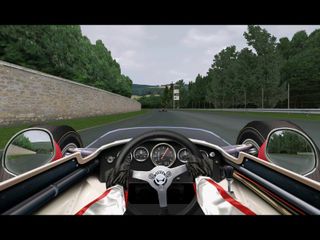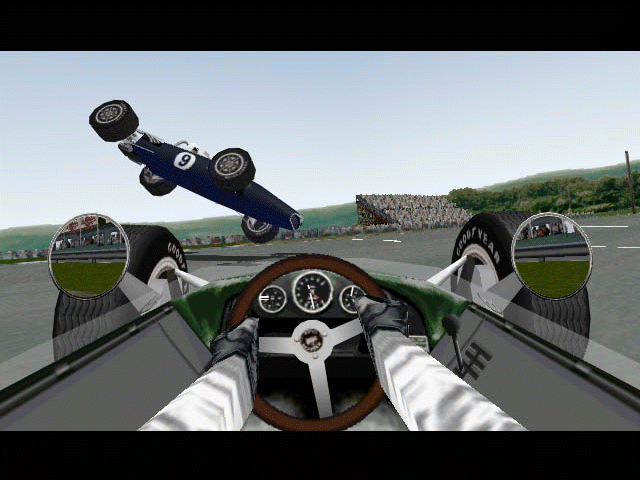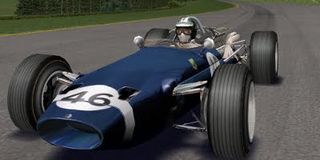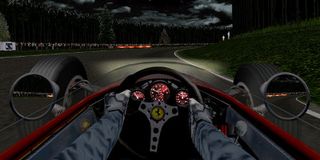Why I loved hardcore racing sim Grand Prix Legends
The story of the racing sim that wouldn’t die.

We're reaching into our extensive archive of magazine features to celebrate great PC games gone by. This article was originally published in PC Gamer UK issue 145 in 2005.
One of gaming’s most passionate communities flourishes today amid a failure. A people united by the perfection of physics and a high-art driving simulator they saved from oblivion.
1998’s Grand Prix Legends was an uncompromising simulation of the 1967 Formula One season: the days when drivers wore goggles and safety was a bucket of sand. Cars with little grip and top speeds of 200mph navigated tracks which ranged from two mile sprints to 14 mile serpentine car-breakers. There were no run-off areas and no safety car. No safety at all. Half the competitors died in 1967 because, at some point, even the greatest drivers lost control. They were not cast as victims but revered as motor-sport martyrs, and GPL gave us the keys to the cars that killed. 400 BHP, fist-wide tires and no downforce. If Jim ‘The Gent’ Clark couldn’t keep it on the black stuff, what chance did the home user have?
Just opening Grand Prix Legend’s packaging was to realise this game was different. A 100-page book (lovingly written by car journalist Steve Smith) fell to your feet. This was a training guide and a history of motorsport ethos—a manual good enough for your shelf. Light your pipe and have a read. Read the warnings. The simulator was unplayable without a steering wheel, and it only worked on 3dfx and Rendition video cards—obscure even in 1998. Grand Prix Legends was progressive, technically innovative, and painfully niche.
Though a critical success it was a commercial failure. The developer Papyrus released the most accurate and demanding driving simulator in gaming history. Then they folded. GPL was nearly impossible to drive—even with the right hardware and hours of prayers. Learning curves weren’t supposed to be this steep. Only a select few would scale it.

For if Grand Prix Legends was safe and easy, everyone could do it and then it wouldn’t be sport any more. It was perversely exciting. Its sim authenticity and physics were the game. The collisions and resultant mêlées made you applaud... with one hand, slapping your forehead with driver’s remorse.
Grand Prix Legends became the enigmatic runt of driving simulators, too repulsive to the casual gamer, an unplayable tech demo: “Just too damned hard”. It should have been killed with the back of a shovel after birth, but the persistent few admirers looked beyond the near unachievable control and impossible AI. One writer memorably described Grand Prix Legends as “Like learning the violin (but with a car)”.
The biggest gaming news, reviews and hardware deals
Keep up to date with the most important stories and the best deals, as picked by the PC Gamer team.
So go to your room and practise this new instrument.
And you did. And you failed. And you dusted yourself off, put antiseptic on your sores and did it again. And failed. Yet after months of chipping away you just felt you were ‘on it’ one day. Everything working; your teeth clenched to a bite; adrenaline high but not intoxicating; yes, if all these factors were in place you might find yourself competing for position with Jochen Rindt, say. Then, as if this wasn’t unexpected enough, you might, just might, be able to slip past him into Monza’s Curva Grande.

At an insane 180mph you’re slip-streaming a few feet from Rindt’s gearbox. Shift down from top gear—much later than normal and jink the car to the inside line—a leap of faith that decelerates the car, dips the nose and makes the rear-end as nervous as a fat turkey in December. But this time your eyes stay open, and with them you can see you’re a nose ahead of Rindt and you have the line into the Lesmos curves. Your leap of racing faith just found the limit. If this is ‘fun’ then fun is sickeningly stressful.
But you’ve just learnt your first lesson and played “Baa Baa Black Sheep” on this violin, a milestone on the long journey to becoming virtuoso.
You’re racing drivers who’ve been dead for 30 years.
Lamentably, this small victory would typically be lost. The competing engine noise, the car in your mirror and your accelerating heart derailing concentration. Inevitably your Lotus would spin before the end of the lap and Rindt drive past your floundering, wounded car—without even noticing you. You’ve just lost it—again.
Eerily, you were racing drivers who had been dead for 30 years. Their ghostly AI was too good for mere mortals and racing in a full grand prix could be dispiriting. These phantom drivers’ relentless, unforgiving brilliance further repulsed the mass market. There was no ‘Easy, Medium, Hard’ with Grand Prix Legends—no lesser options were available. But, you’d already learnt a lesson and your first song on the violin—it was time to play your first public concert. Click the ‘Multiplayer’ option.
By doing so you were entering a ‘Top Gun’ school for driving simulator addicts. Only a few would prove they had the right stuff to compete. A cult grew.

Driving clubs appeared. Leagues of drivers: a breed more dexterous than a musician with the concentration of an air traffic controller. The world’s driving simulator select, united by challenge and modems. As racers got faster, so did computers and phone lines. New software was needed and, as necessity breeds invention, websites appeared with downloadable replays and set-up advice. It was too fragmented. The simulation Zionists needed a homeland and settled in VROC.
Virtual Racing On-Line Connection was an application co-created by beta tester Alison Hine, which enhanced the multiplayer capabilities by enabling racers to host, find, meet ‘n’ beat other fanatical Grand Prix Legends enthusiasts. A proper portal. The community coalesced around VROC before finally planting their flag at RaceSimCentral, where they live today.
The violinists had formed an ensemble. There now appeared to be more sites on the internet than people who actually bought the original game. Replay sites, set-up sites, track editor sites, car model sites, new texture sites, hot lap sites, online league sites, off line league sites, ‘Good behaviour’ guides—for Grand Prix Legends was an honourable sport. One can imagine 1962 World F1 Champion Graham Hill nodding approvingly, stroking his moustache and opening a very good 1957 Moet & Chandon.
Graphical tweaks and new tracks were acceptable modifications, but cheating was unheard of in the community. The simulator was considered un-hackable and the source code more secure than the recipe for Coca-Cola. You either had speed or you didn’t—there was no way to fake your supremacy. But this is computing, and, if a 12-year-old can hack Pentagon computers, then sooner or later someone was going to tamper with Grand Prix Legends.
Most Popular

